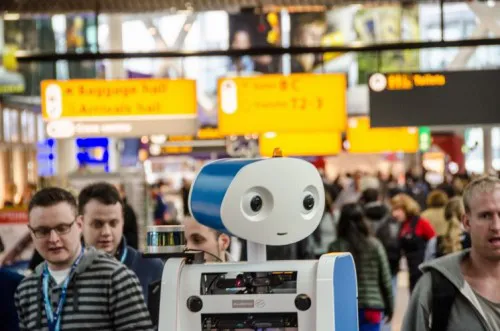
Robot helps passengers find their gate at Amsterdam Schiphol Airport
Apr 20, 2016

At Amsterdam Schiphol Airport, a friendly robot has been introduced to assist passengers in locating their departure gates. This innovative technology enhances the travel experience by providing real-time directions and information, helping travelers navigate the bustling airport environment with ease. The robot features a user-friendly interface, capable of understanding multiple languages, ensuring accessibility for international visitors. By offering guidance and answering questions, it not only alleviates stress for passengers but also streamlines the flow of foot traffic within the terminal. This initiative highlights Schiphol's commitment to leveraging technology to improve customer service and create a more efficient airport experience.
In recent years, technology has made significant strides in enhancing the travel experience, and Amsterdam Schiphol Airport is at the forefront of this innovation. One of the standout features at this major international airport is the use of robots to assist passengers in navigating the terminal. These intelligent machines help travelers find their gates, making the journey through the airport smoother and more efficient.
Why Robots are Essential at Schiphol Airport
The bustling environment of Schiphol Airport can be overwhelming for many passengers. With millions of travelers passing through each year, the need for clear and immediate assistance is paramount. Robots are becoming an integral part of the airport's service strategy, offering real-time information and guidance. Here are some key benefits of using robots at Schiphol:
- Efficiency: Robots can quickly provide directions, reducing waiting times and helping passengers reach their gates faster.
- Accessibility: The robots are designed to be user-friendly, making them accessible for all passengers, including those with disabilities.
- 24/7 Availability: Unlike human staff, robots can operate around the clock, ensuring that assistance is always available.
How the Robots Work
At Schiphol Airport, the robots are equipped with advanced navigation systems and artificial intelligence. They can understand passenger queries and provide information in multiple languages. The process is straightforward:
- When a passenger approaches a robot, they can ask for assistance with their gate information.
- The robot quickly processes the request and retrieves the necessary data.
- It provides clear, step-by-step directions to the relevant gate, often accompanied by visual aids on its screen.
This seamless interaction not only enhances the passenger experience but also relieves some of the pressure on airport staff, allowing them to focus on more complex inquiries and tasks.
Passenger Feedback and Reception
The introduction of robots at Schiphol Airport has been met with positive feedback from passengers. Many travelers appreciate the friendliness and efficiency of the robots. According to a recent survey, over 75% of passengers felt that the robots significantly improved their overall airport experience.
| Feedback Category | Percentage of Positive Responses |
|---|---|
| Ease of Navigation | 80% |
| Response Speed | 78% |
| User-Friendliness | 82% |
| Overall Satisfaction | 75% |
Future Developments in Airport Robotics
The success of robots at Schiphol Airport paves the way for future advancements in airport technology. Increased automation is expected, with plans to integrate more sophisticated AI systems that can handle a broader range of passenger needs. Future developments may include:
- Smart Luggage Handling: Robots that assist with luggage tracking and delivery.
- Enhanced Communication: Systems that provide real-time updates on flight status and gate changes.
- Personalized Assistance: Tailored services based on passenger profiles and travel history.
As technology continues to evolve, the role of robots in airports will likely expand, further improving efficiency and passenger satisfaction.
Challenges and Considerations
While the implementation of robots at Schiphol Airport has been largely successful, there are challenges to consider. Technical malfunctions can occur, and the airport must ensure that there are contingency plans in place for such situations. Moreover, continuous updates and maintenance of the robots are necessary to keep them functioning optimally.
Another important consideration is passenger comfort. Some travelers may feel uneasy interacting with machines instead of human staff. Therefore, it is essential for airports to strike a balance between technology and human interaction to ensure a welcoming atmosphere.
Conclusion
The integration of robots at Amsterdam Schiphol Airport showcases how technology can enhance the travel experience. By providing quick and efficient assistance, these robots help passengers navigate one of Europe's busiest airports. As the travel industry continues to evolve, innovations like this will play a crucial role in shaping the future of air travel. With ongoing improvements and increased adoption of robotic technology, passengers can look forward to a more streamlined and enjoyable experience at airports around the world.
In conclusion, the use of robots at Schiphol Airport represents a significant step towards a more efficient and customer-friendly travel experience. As technology progresses, the potential for robots to assist passengers will only grow, making air travel more accessible and enjoyable.
Related Articles

Explore Thailand: The Best Islands to Visit for Paradise, Adventure, and Relaxation

The Ultimate Guide to the Best Islands in Thailand for Your Next Getaway

Do babies need passports? How to get a passport for a newborn

How to get a U.S. passport fast: here’s how to expedite the process

What is Mobile Passport Control: 5 reasons why you should use it

SENTRI vs. Global Entry: A detailed guide

Do you need a passport to go to the Bahamas? Let’s find out

Do you need a passport to go to Mexico? A detailed guide

Do you need a passport to go to Canada? We got the answer

Do You Need a Passport for a Cruise: An Essential Travel Guide

Booster Seat Requirements: All the Rules to Follow in Your Rental Car

What Are the World’s Most Powerful Passports, and How Does Yours Rank?

How to Take a Passport Photo at Home: A Helpful Guide

You've got to have heart! Southwest's new livery

Your opinion: Should water be free on low cost carriers?

Young women bolder than guys as solo travellers
